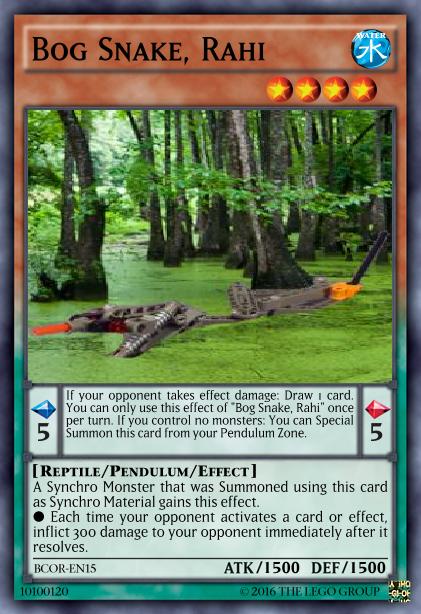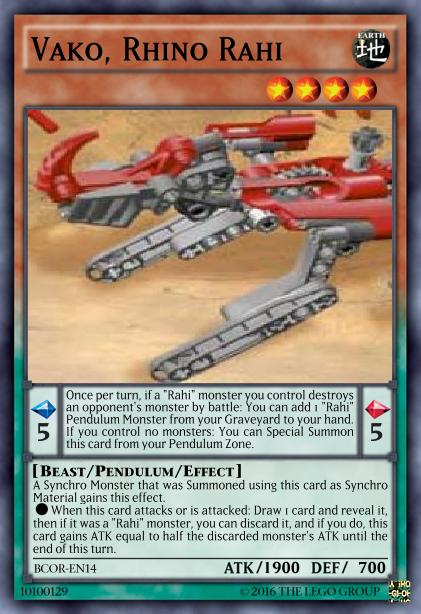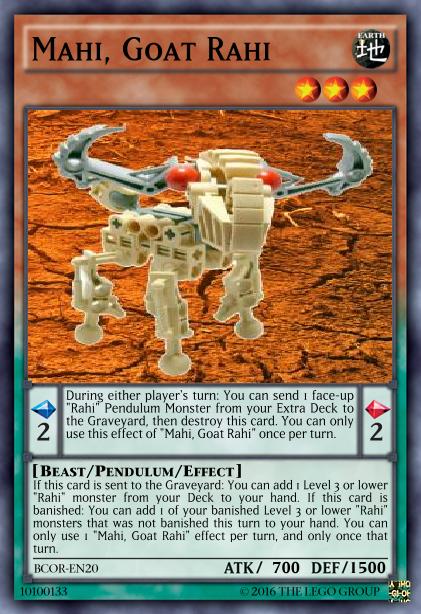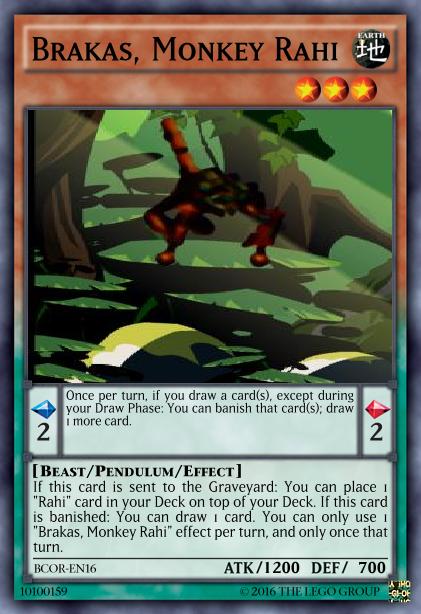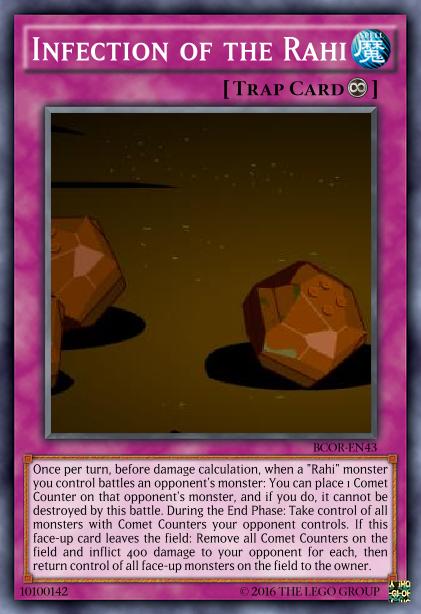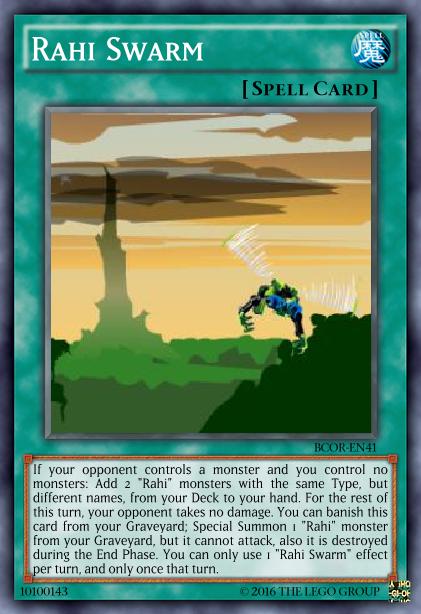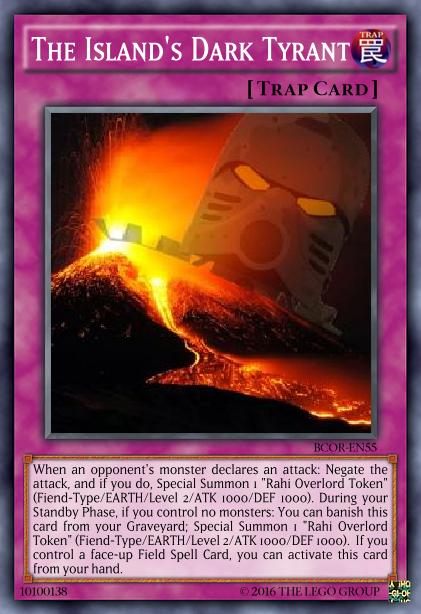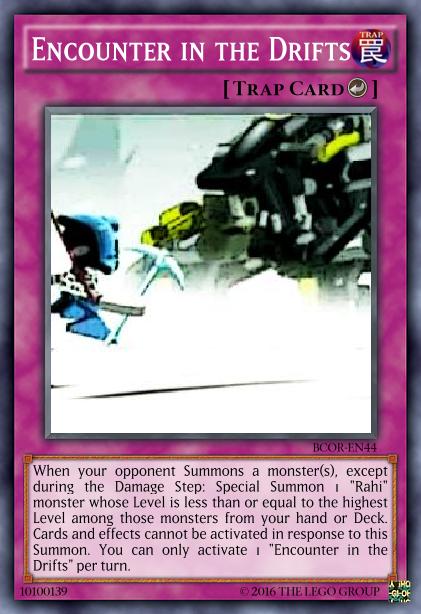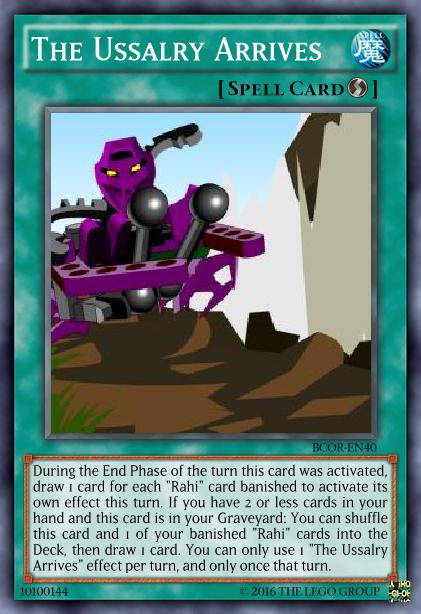The Rahi that live on Mata Nui form a huge archetype consisting of several subthemes, each of which follows a different common design idea. Since archetypal support cards work for all of them, they can be combined in a variety of ways, though not all of them necessarily make sense or function. I think the most straightforward way to do this would be to look at each of the subthemes separately, so here we go.
- Big Rahi (Normal Pendulums)
- Level 4 Rahi (Effect Pendulums / Synchro Fodder)
- Level 3 Rahi (Effect Pendulums / GY and banish shenanigans)
- Level 2 Rahi (Tuners / Handtraps)
- Rahi Spells/Traps
- Conclusion
Big Rahi (Normal Pendulums)






The Rahi mainly featured in the 2001 storyline were the larger types, sold as sets in pairs – mostly just two of the same species, but also the combination of Muaka & Kane-Ra. Based on this idea, these Rahi are Normal Pendulum Monsters with the gimmick that the scales (one 3 and one 8, to comfortably cover all their levels) are meant to match in terms of Type. The Reptile Tarakava is paired with the Reptile Sand Tarakava, the Beast Kane-Ra with the Beast Muaka, and the Insect Nui-Jaga with the Insect Nui-Rama. When this is the case, the shared effects split between the two sides of each pair make it so that your Pendulum Scales become indestructible and your Pendulum Summons cannot be responded to, basically setting the whole mechanic to easy mode.
In addition, each of them has a unique second Pendulum Effect, probably best to explain this with a little table:
Name | Type | Scale | Effect | Explanation |
|---|---|---|---|---|
Tarakava, Lizard Rahi | Reptile | 3 | Self-destruct to summon Rahi Pendulum from ED on direct attack | Tarakava are known for surprise attacks, in this case launched from the Pendulum Zone/ED |
Kane-Ra, Bull Rahi | Beast | 3 | If only face-up monster you control is a Rahi, it gets +1000 ATK and effect protection | Kane-Ra are not herd animals, so solitary Rahi get buffs |
Nui-Jaga, Scorpion Rahi | Insect | 8 | Add Rahi Pendulum from ED to hand, then destroy card in Pendulum Zone | No particular lore relation intended, could be Nui-Jaga calling each other? |
Muaka, Tiger Rahi | Beast | 8 | Gain LP when Rahi destroys opponent’s monster by battle | Opponent’s monsters get eaten by your Rahi |
Nui-Rama, Fly Rahi | Insect | 3 | Summon Rahi with same type as and lower or equal level than a Rahi you control from Deck | Nui-Rama form large swarms, this helps you do the same |
Sand Tarakava, Lizard Rahi | Reptile | 8 | Place Rahi you control in Pendulum Zone (Quick Effect) | No particular lore relation intended, but complements Tarakava’s effect |
So, you have set up the paired scales of your choice and Pendulum Summoned a bunch of monsters in one turn, now what do you do with them? The Rahi archetype offers two answers that fit in this section.
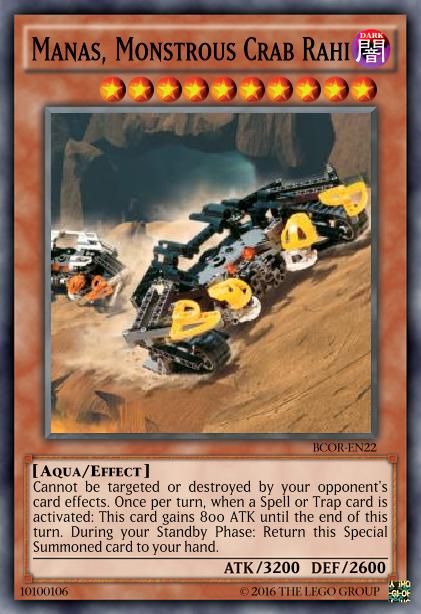

You could just use them as tributes to summon the Manas, a big beefy boss with protection from targeting and effect destruction that can also power itself up further with heat (where heat means Spells and Traps). Or, if you want something more creative, you could add to the mix the Fikou, a little Level 1 Rahi that can banish itself from the GY and reduce a Rahi’s Level by 1 to Special Summon another Fikou from the Deck. Since it also happens to be a Tuner, this opens the path to some more big Rahi that live as Synchro Monsters in the Extra Deck.
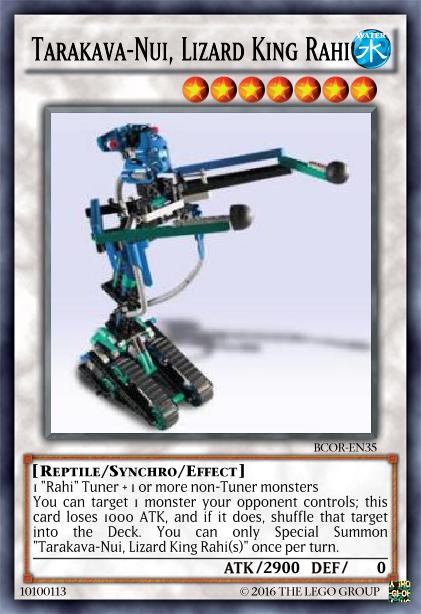


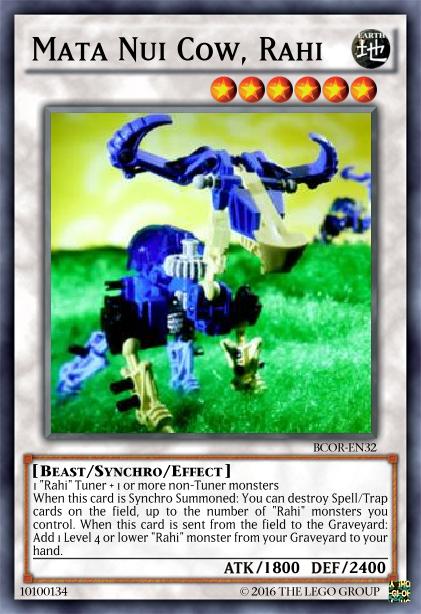
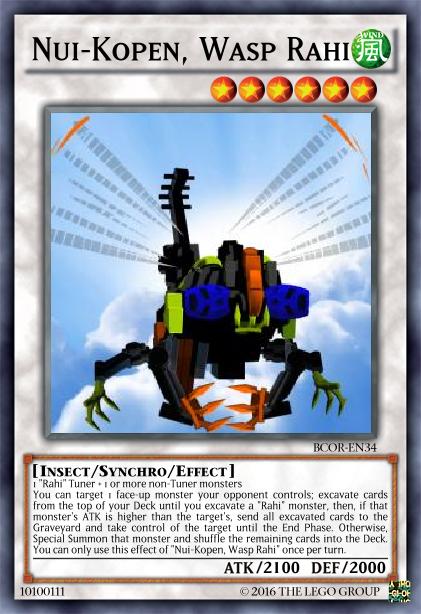
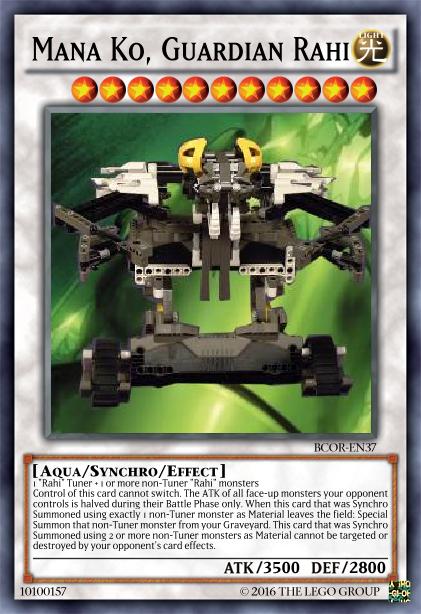
Basically, these are the combiners made from the Level 5 and above Rahi shown before, with a Mukau Mata Nui Cow snuck in because I guess it’s a combiner as well. All of them require a Rahi Tuner, and, the obvious bovine exception aside, are one level higher than their corresponding main deck monster. So that + Fikou makes the respective combiner. Since there aren’t really any major common features beyond that, I’ll have to briefly explain their designs one by one.
Tarakava-Nui, the king of the punchy lizards, punches things so hard they go back into the Deck. Rather than a regular once per turn restriction, each use is paid with 1000 of its 2900 ATK, so theoretically there’s nothing stopping you from buffing it a whole bunch and getting rid of the entire field that way. Might not be okay that that’s allowed. Well, at least there’s a clause preventing you from summoning multiple in a turn to make abuse a bit harder.
Kuma-Nui, the Muaka & Kane-Ra combiner that obviously represents a rat, can blow up Spells and Traps on the field at the start of the Battle Phase and buff itself if it hit any of yours. The choice between face-up and face-down cards grants you a limited way to control what exactly is affected, so you can selectively use it either for the ATK boost or to clear out backrow.
The Gukko-Kahu, a very important Rahi for the Matoran society and an alternate model of the Nui-Jaga set, couldn’t be screaming any louder to use it as an intermediary step in Synchro climbing. It straight up gives a draw when it enters the field and a search when it leaves.
The Mukau Mata Nui Cow is a Rahi that is not built from other Rahi, but from two Toa, namely the Gali and Pohatu sets. Therefore, its effects (which use the same triggers as the Gukko-Kahu) are modeled after the original versions of those Toa: One destroys Spells and Traps, the other recycles monsters in the GY.
The Nui-Kopen, alternate Nui-Rama model, played a significant role in the 2001 storyline’s most prominent example of mind control via infected masks, so it has an effect that lets you take control of an opponent’s monster. The excavation stuff to go along with that really doesn’t have any deep reason, just thought it would be fun when I made this. I wasn’t wrong.
Finally, the Mana-Ko is the biggest Rahi so far, outdoing even the Manas (its base model) with a Level of 11 and 3500 base ATK. On the effect side, it’s immune to control changes (Order of Mata Nui mental shielding, says the LORE), halves your opponent’s monsters’ ATK during their Battle Phase to make destruction by battle unlikely, and has a different third effect depending on its materials. If there was just one non-Tuner, it floats into that monster, which will usually be a Manas. If there were multiple, it instead gains the same protection as the Manas. Since this is the final big boss, it has the special condition of requiring Rahi for both the Tuner and non-Tuner materials.
Level 4 Rahi (Effect Pendulums / Synchro Fodder)
Moving on to less gargantuan beasts, we have a category mainly composed of models from the Master Builder Set (which was technically from 2002, but contained a lot of Rahi that already appeared in 2001 material). Their shared features are exactly two:
- They can be Special Summoned from the Pendulum Zone if you control no monsters.
- Using them as Synchro Material grants the summoned monster additional effects.
Beyond that, they can be divided more or less loosely into three distinct subgroups. The first is what I sometimes call the “negation Rahi”.


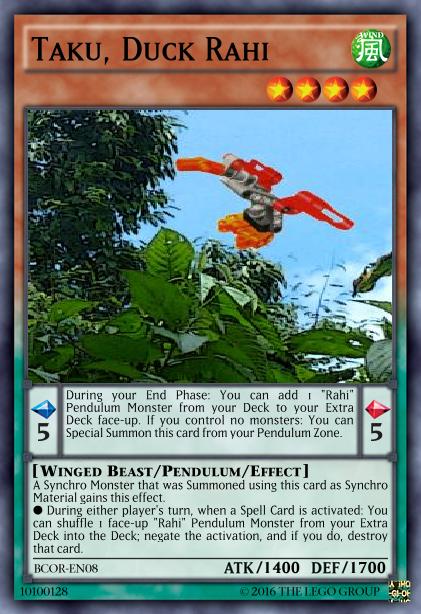
All of these grant the Synchros summoned with them a nearly identical effect, which allows negating activations of a certain card type by shuffling Rahi Pendulums from the Extra Deck back into the Deck. This is also not once per turn, so it can get really oppressive depending on how loaded up on ammo you are. Their unique Pendulum Effects are designed to work as a little engine that helps set all of this up, so this trio of Rahi actually serves as a pretty good centerpiece for a deck.
As the second group we have “destruction Rahi”, which are connected through their Pendulum Effects that all trigger when another card in the Pendulum Zone is destroyed.
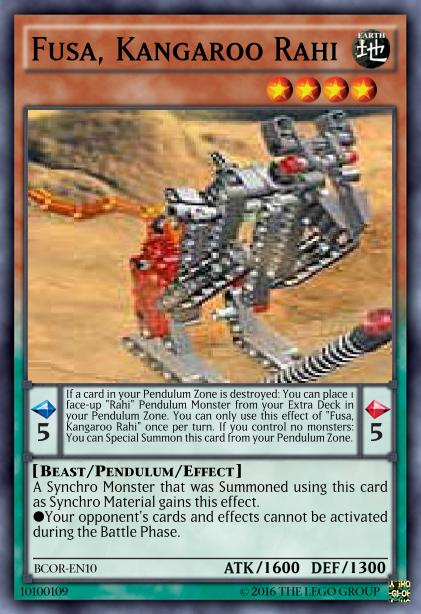
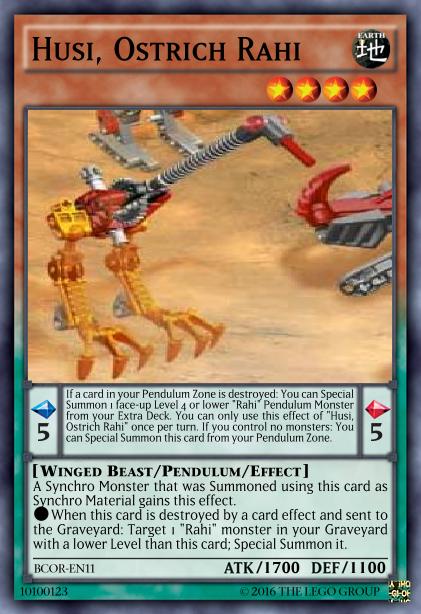

This potentially serves as a counterplay to an opponent’s attempt to destroy Pendulum Scales (though hitting the monster with the destruction trigger would avoid this, so you can’t really expect it to happen), but more importantly has synergy with some other Rahi that blow themselves up with their Pendulum Effects. We have already seen the Tarakava, and a few others will follow in the Level 3 section.
The Pendulum Effects can be quickly summarized by saying that the Fusa replaces the destroyed scale, the Husi gets you a Special Summon from it, and the Makika destroys an opponent’s card in retaliation. The monster effects on the other hand are a bit more diverse.
The Fusa makes it so the Synchro Monster that used it as material shuts down all your opponent’s effects during the Battle Phase.
The Husi, similar to its Pendulum Effect, makes the Synchro float into reviving a lower Level Rahi monster.
And the Makika also continues its original theme of retaliation by allowing a Synchro Monster to strike back in a rather painful way against any monster that destroys it by battle.
With these two sub-sub-themes done, it’s about time to admit I lied a little when I said there were three groups. It’s actually more like two groups plus the rest that doesn’t fit into either of them. Each of these leftover Rahi instead just kind of synergizes with itself.
The Takea can double a Rahi’s battle damage from the Pendulum Zone, and a Synchro Monster summoned with it can Special Summon additional Rahi from the Deck in proportion to the battle damage it inflicts.
The Bog Snake makes Synchros gradually damage your opponent as they play, and in the Pendulum Zone lets you have a free draw per turn if your opponent takes effect damage.
The Vako gives Synchro Monsters a chance to increase their ATK when they battle, or alternatively just draw you a card. The Pendulum Effect lets you have the best of both worlds from this effect because you can immediately recover a Rahi from the GY if your Rahi destroys an opponent’s monster by battle.
Finally, there is a Synchro specifically designed to go with these cards.
The Dikapi, a combiner of Pohatu and Onewa, has exactly the right level to be made with a Level 4 Rahi plus the Fikou. Once on the field, it can then change itself to any lower level and reuse the Rahi Pendulum Monster sent to the Extra Deck this way for another Synchro Summon. So Level 4 Rahi + Fikou makes any Synchro from Level 5 to 9, which then gains whatever effect the Level 4 grants.
Level 3 Rahi (Effect Pendulums / GY and banish shenanigans)
One step further down on the Level ladder, we find another type of Rahi. These are characterized by having two monster effects that trigger when sent to the GY and banished, respectively, plus one Pendulum Effect following no particular pattern. Their Pendulum Scales are all 2, so when paired with the Level 4 Rahi who all have a Scale of 5, it becomes possible to summon exactly the Rahi from this section and the previous one.
There is one additional pattern that can be found in some of these monsters, namely that the GY trigger effect consists of Special Summoning another Level 4 or lower monster of the same Attribute from the GY. This obviously has some really broad synergy with the non-custom card pool, so chances are they’re completely broken in the hands of someone making even a little effort to abuse them. Anyway, let’s look at what else they do.
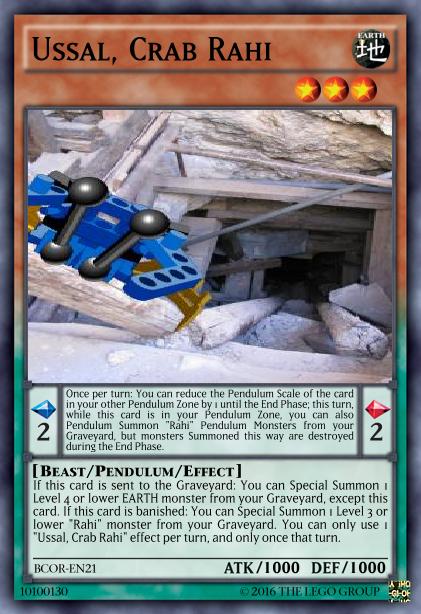

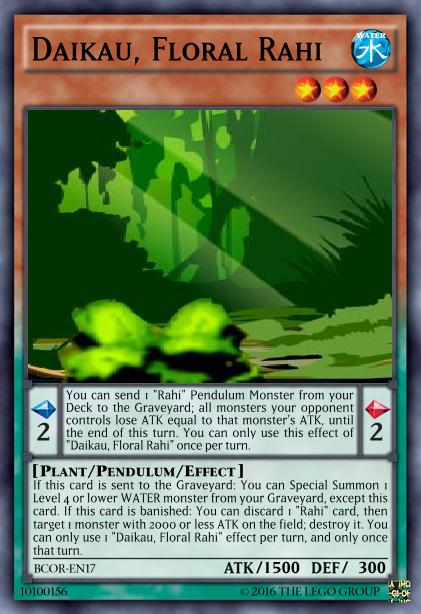
Name | Attribute | Pendulum Effect | Banish Effect |
|---|---|---|---|
Ussal, Crab Rahi | EARTH | Allow Pendulum Summoning Rahi from GY | Special Summon Level 3 or lower Rahi from GY |
Kewa, Vulture Rahi | WIND | Search a WIND monster, destroy self during End Phase | Add Rahi card from GY to hand |
Daikau, Floral Rahi | WATER | Send Rahi Pendulum from Deck to GY to reduce ATK of opponent’s monsters | Discard Rahi to destroy monster with <=2000 ATK |
Other Level 3 Rahi provide a variety of effects to support the archetype, and mostly its Level 3 or lower subset.
The Mahi‘s Pendulum Effect provides the solution to the glaring inherent problem Pendulum Monsters with GY effects have: They go from the field to the Extra Deck rather than to the GY. This effect allows you to send a Rahi where you actually need it to be and then destroys the Mahi itself, potentially triggering the effect of the other Scale. Its own GY trigger is a simple search for Level 3 or lower Rahi monsters (notably, even itself – not sure anymore how intentional that was), and its banish trigger brings a Rahi banished in a previous turn back to your hand.
The Moa can switch its Pendulum Scale to another Rahi monster’s by banishing that monster directly from the Deck, which of course has the very valuable alternate use of just immediately triggering any banish effect you might want. When sent to the GY, it puts any Rahi card back into the Deck, and when banished it Special Summons a Level 3 or lower Rahi from the hand.
The Brakas has overall much less archetypal effects and is another of those cards that mainly has synergy between its own different effects. When sent to the GY, it places any Rahi card from the Deck on top of the Deck. When banished, it lets you draw a card. And in the Pendulum Scale, it gives you the option to banish that card (which may very well be a Rahi with a banish trigger) to immediately draw one more.
For this group as well, there are some Synchro Monsters that go with it. Both of them are based on official models that also came out in 2001, but don’t have any actual relation to the sets that were sold in stores.
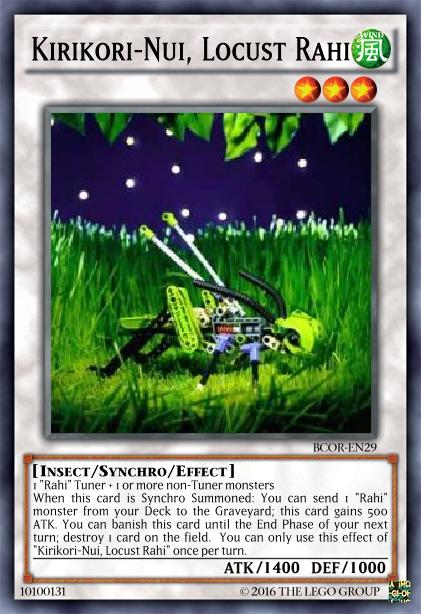
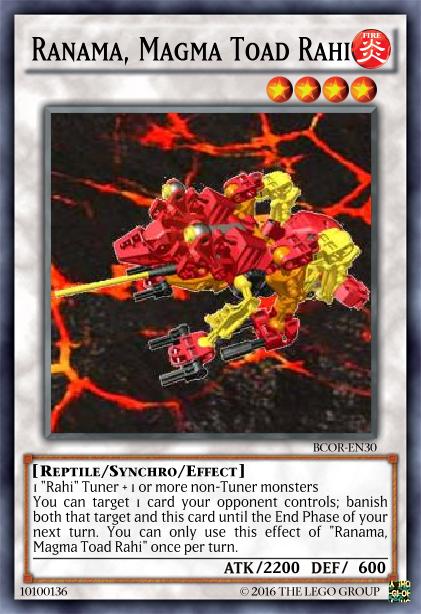
Kirikori-Nui is itself a Level 3 Rahi, meaning it can be made just by putting any of the main deck monsters from this section on the field while having a live Fikou in the GY. And it is also a valid target for any of the many effects specifying Level 3 or lower Rahi, like the Ussal or Mahi. With its own effects, it can send a Rahi directly from the Deck to the GY to reach a more respectable ATK value, or non-targetingly get rid of another card by temporarily banishing itself.
The Ranama offers a similar form of removal, but instead temporarily banishes both itself and the other card. However, this does target, so which is more effective mostly depends on the situation.
Level 2 Rahi (Tuners / Handtraps)
With all these Pendulum Monsters and Synchro Monsters, it’s starting to look like the Fikou is a bit overloaded as the sole main deck Tuner of the archetype. And that’s why there are also others.
These Level 2 Rahi all have powerful handtrap-like effects that require you to banish themselves from the hand or field and an additional Rahi from the GY, so combining them with the Level 3 Rahi is key to using them to their fullest potential.
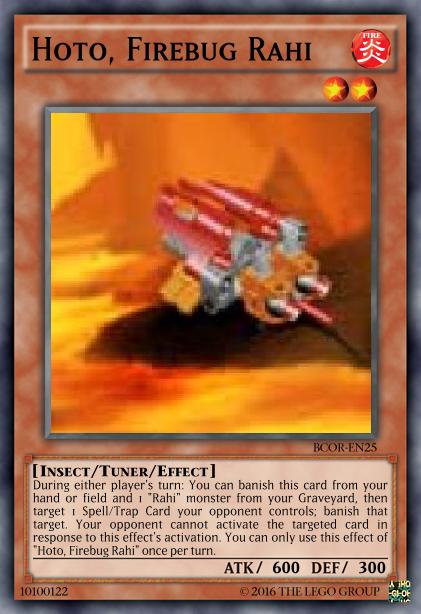

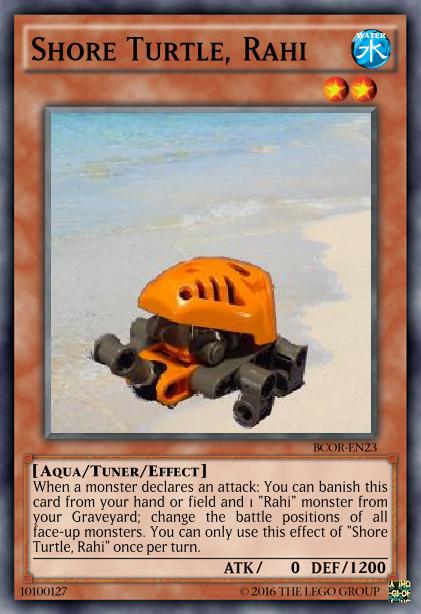

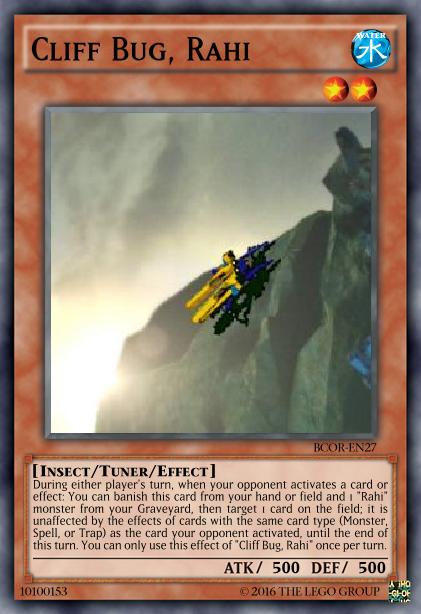
The Hoto banishes a Spell or Trap from the field, the Ruki destroys a monster, the Shore Turtle changes all battle positions on the field in response to an attack (I’ve had a lot of fun with this one), the Lightning Bug negates a face-up monster’s effects, and the Cliff Bug makes a monster unaffected by a certain card type depending on what your opponent is trying to do.
A particularly fruitful strategy is combining these little guys with the Mahi from the Level 3 section, which searches them when it goes to the GY and can recycle a monster banished in a previous turn when it gets banished as cost. With multiple of them, you can set up a nice stable loop.
Rahi Spells/Traps
In addition to the plentiful monster lineup, there are also some spells and traps belonging to or supporting the Rahi archetype. Keeping with the theme of Pendulum Monsters with GY effects and to establish a connection with Makuta, all the Spells also have secondary effects that can be activated by banishing from the GY.
The cards that are formally part of the Rahi archetype depict various key events in the struggles between the Matoran of Mata Nui and the Rahi controlled by Makuta.
Devastation of the Rahi is based on the battle that became the origin of the charred forest, and with its main effect essentially provides that kind of brutal mutual (brutual?) destruction between your Rahi and whatever the opponent is playing. The GY effect further makes use of any Rahi that may have ended up there to banish something from the field.
Siege of the Rahi takes its inspiration from the Tarakava attack on Ga-Koro, using the pressure of a big Rahi on the field to make small monsters your opponent summons take refuge in the face-down Defense Position, rendering them mostly useless. However, the Siege ends as soon as you do not have said big Rahi anymore, so the GY effect simply helps you protect them.
Infection of the Rahi, the only Trap bearing the Rahi name, covers the devious scheme of a certain Po-Koro merchant collaborating with Makuta. Rather than simply beating down their enemies, your Rahi will now be used to infect them, which lets you take control of them at the end of the turn. This only lasts as long as the card remains intact, but it deals some damage when it leaves just to be petty.
Rahi Swarm is about the Nui-Rama swarms attacking Le-Koro, and similar to the concept of the Nui-Rama’s own effect, it searches Rahi with matching types – so you can complete the properly paired scales of the big Rahi in one shot. In the GY, the word “swarm” is taken literally in a different sense, and it just helps you swarm the field.
Rahi Hive Showdown, the card version of the iconic battle between Onua and an infected Lewa, takes control of one high-ATK monster your opponent controls if they have multiple, pitting the two heroes against each other. In the GY, it can steal a small monster from your opponent during their Main Phase, which is obviously quite annoying. Yeah, despite being a Rahi card in name, this doesn’t really interact with the Rahi archetype at all, other than being searchable and stuff.
The opposite is true for the following three cards, which support Rahi without having them in their name.
The Island’s Dark Tyrant represents Makuta’s ability to control not only the Rahi, but the very land itself. Which he barely ever used, but whatever. The main thing this card does with both its regular activation and banish-from-GY effects is Special Summoning a Token that also counts as a Rahi, which can then be used as Synchro fodder. And with an active Field Spell, it can be activated from the hand.
Encounter in the Drifts is a Counter Trap that responds to an opponent’s Summon by having a Rahi suddenly pop out. So suddenly, in fact, that there is not even a way to respond to the Summon. Technically the restriction of only being able to Summon Rahi of lower or equal levels than the opponent’s monster contradicts the depicted scene of a Muaka (Level 7) surprising Matoro (Level 2), but this way is pretty fun anyway.
The Ussalry Arrives works more or less like Super Rejuvenation, giving you a number of draws in the End Phase equal to how many Rahi you banished for their own effects this turn. Meanwhile, in the GY, it can just recycle itself and some banished Rahi card into the Deck in order to draw yet another card. You can always count on the Ussalry as reliable backup.
Conclusion
There are a lot of Rahi. There are, in fact, way too many Rahi to really say there is one specific way of playing them. Depending on how you mix and match the different Level ranges and themes, you could
- go full caveman beatdown with Kane-Ra, Muaka, Kuma-Nui, Takea, Vako, etc.
- use the Hikaki/Kofo-Jaga/Taku negation trio to make arbitrary Synchro Monsters into game-controlling bosses.
- use cards like Siege, Showdown, or the Level 2 Tuners to constantly interfere with your opponent’s attempts to play.
- do any combination of the above.
- probably follow some other (possibly broken) strategy I didn’t even consider.
The broadest statement I can make is that whatever you play, you’re probably going to get a lot of mileage out of filling up the GY, which is kind of a funny property for a Pendulum archetype to have. If (when?) I eventually update these designs, I definitely want to keep that aspect, and I’ll probably focus more on establishing concrete sub-strategies for the archetype (perhaps divided by Type?) so it becomes easier to balance in a controlled way. This seems especially important considering new Rahi will be added for many, many expansions (hell, Rahi Beasts didn’t come out until 2005), and I’ll have to find a way to design them so they fit neatly into the archetype’s card pool. That’s going to be a challenge, a Challenge of the Rahi you could say. Ha.
Various sample decks are included with the BCOR release in the deck folder.


